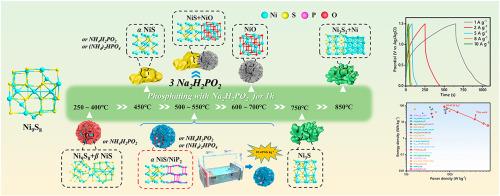由磷酸化热力学控制的相演化使集成的NiS/NiP2电极具有增强的伪电容性能
IF 3.5
3区 化学
Q2 CHEMISTRY, INORGANIC & NUCLEAR
引用次数: 0
摘要
过渡金属硫化物(tms)和磷化物(TMPs)复合材料由于具有较高的储能容量和快速的充放电动力学,被认为是赝电容储能极具发展前景的材料。然而,由于硫和磷原子在与过渡金属反应时的竞争配位行为,精确和高效地合成高度集成的tms /TMPs异质结构仍然是一个重大挑战。本研究以Ni9S8为前体,通过精确控制磷酸化温度(490 ~ 570℃)、磷源(NaH2PO2)和反应时间(1 h),成功地一步合成了NiS/NiP2一体化电极。综合实验研究表明,最佳温度范围的选择至关重要,低于490°C的温度会阻碍磷的扩散,而高于570°C的温度会促进磷源分解过程中产生的含氧中间体与NiO的反应,从而促进NiO的生成。电化学分析表明,所得到的NiS/NiP2复合材料在1 a g−1时的比电容为1721.8 F g−1,优于之前报道的大多数基于tms和tmps的电极。此外,在所制备的NiS/NiP2//NC非对称超级电容器在749.60 W kg - 1的功率密度下提供高达89.41 Wh kg - 1的能量密度,并且在1 a g - 1下循环10,000次后保持其初始电容的91.32%,表明了出色的循环稳定性。这项工作为开发具有增强电化学性能的集成硫化物-磷化物电极材料的磷酸化条件提供了有价值的实验见解。本文章由计算机程序翻译,如有差异,请以英文原文为准。

Phase evolution governed by phosphorization thermodynamics enabling an integrated NiS/NiP2 electrode with enhanced pseudocapacitive performance
Transition metal sulfides (TMSs) and phosphides (TMPs) composites are considered promising electrode materials for pseudocapacitive energy storage due to their high energy storage capacity and rapid charge/discharge kinetics. However, the precise and efficient synthesis of well-integrated TMSs/TMPs heterostructures remains a significant challenge, primarily due to the competitive coordination behavior between sulfur and phosphorus atoms during their reaction with transition metals. In this study, Ni9S8 was employed as a precursor, and through precisely controlling the phosphorization temperature (490–570 °C), phosphorus source (NaH2PO2), and reaction time (1 h), a one-step synthesis of an integrated NiS/NiP2 electrode was successfully achieved. Comprehensive experimental investigations reveal that the selection of an optimal temperature range is critical that temperatures below 490 °C impede phosphorus diffusion, while temperatures above 570 °C promote the undesired formation of NiO due to reactions with oxygen-containing intermediates generated during the decomposition of the phosphorus source. Electrochemical analyses demonstrate that the resulting NiS/NiP2 composite exhibits a specific capacitance of 1721.8 F g−1 at 1 A g−1, outperforming most previously reported TMSs and TMPs-based electrodes. Furthermore, the fabricated NiS/NiP2//NC asymmetric supercapacitor delivers an energy density of up to 89.41 Wh kg−1 at a power density of 749.60 W kg−1 and retains 91.32 % of its initial capacitance after 10,000 cycles at 1 A g−1, indicating excellent cycling stability. This work provides valuable experimental insights into phosphorization conditions for the development of integrated sulfide-phosphide electrode materials with enhanced electrochemical performance.
求助全文
通过发布文献求助,成功后即可免费获取论文全文。
去求助
来源期刊

Journal of Solid State Chemistry
化学-无机化学与核化学
CiteScore
6.00
自引率
9.10%
发文量
848
审稿时长
25 days
期刊介绍:
Covering major developments in the field of solid state chemistry and related areas such as ceramics and amorphous materials, the Journal of Solid State Chemistry features studies of chemical, structural, thermodynamic, electronic, magnetic, and optical properties and processes in solids.
 求助内容:
求助内容: 应助结果提醒方式:
应助结果提醒方式:


